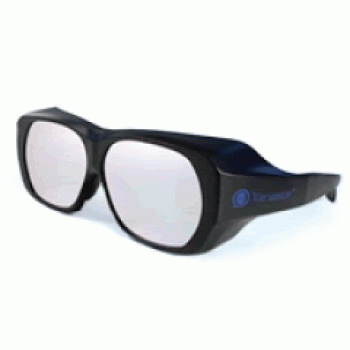Usability & Universal Design / Variantor Dichromatic Spectacles
Variantor Dichromatic Spectacles

Colour vision deficiency simulation glasses.
An experience based tool that can be used to aid colour universal design, Variantor helps you to understand what the world looks like to color deficient people.
Just by wearing Variantor, allows you to very simply experience first-hand the confusing colour combinations such people see.
Guide Price: £300
SKU: N2600

Why do we need Colour Universal Design?
For colour vision deficient people, it is difficult to distinguish colours between, for example, red and green with similar intensity. Colour vision deficiency affects a significant number of people. It occurs in about 6-8% of males in Europe and about 200 million people worldwide.

How to use Variantor?
 1. Let's design as usual
1. Let's design as usual
This figure is coloured in pink and light blue. For normal colour vision people, there is no problem.
 2. See the figure with Variantor
2. See the figure with Variantor
With Variantor, we notice that pink and light blue are confusing for people with colour vision deficiency. Colour legends are also confusing.
 3. Change the colour and shape
3. Change the colour and shape
Different colours are chosen and polka-dot pattern and white lines are added. Legends are directly written in the figure.
 4. Check it with Variantor again.
4. Check it with Variantor again.
This figure is colour universal accessible both for people with normal colour vision and people with colour vision deficiency.
Usage environment
Use the product in environments where there is sufficiently bright outdoor light or in an office or home under normal lighting conditions.
Appropriate effects may not be obtained when the product is used in environments where there is insufficient brightness.
Do not drive a vehicle or operate a machine while wearing this product. In particular, it is extremely dangerous for a person with normal colour vision to drive a car while wearing this product because their ability to recognize traffic signals and signs will be significantly lowered compared to persons with colour vision deficiency, who have learned to compensate for their disabilities through long years of experience.
How to wear the product
Variantor is an over-spectacles-type design, which can be worn over ordinary spectacles for vision correction. Just put them on like standard spectacles and observe real objects through the center of the filter. Appropriate effects may not be obtained when observing objects through peripheral areas of the filter. Do not use Variantor with the filter tilted.
Explanation of consent requirement
Using this product has almost the same effect as taking a colour vision test. Therefore, it may happen that the person wearing the product becomes aware that they have a colour vision deficiency because of their much smaller range of colour discrimination. So only those who understand the potential risks of finding out the true status of their colour vision (whether they have colour vision deficiency or not) should use it.
There is a possibility that others may learn that the wearer has a colour vision deficiency when they explain how they perceive colours. Before the wearer tells others how they perceive colours, please be fully aware that other parties may learn of any defects they may have in their colour vision.
When children use this product, obtain the consent of their parent or guardian before use.
Product description
By wearing this product, people with normal colour vision can experience the challenges experienced by those who have a colour vision deficiency. Variantor simulates the difficulties of distinguishing colours (which colours are difficult to distinguish from each other). Variantor does not reproduce how people with a colour vision deficiency experience colours (what colours they actually see).
The special Variantor filters are designed to detect colour combinations that individuals with protanopia or deuteranopia find difficult to distinguish simultaneously.
Variantor is intended to assist development of appropriate colour design by reproducing the difficulties associated with distinguishing colours in cases of protanope and deuteranope. Thus, Variantor does not reproduce all the patterns of colour vision or confusing colour combinations.
Variantor is designed on the assumption that only reflective objects such as printed matter or advertising displays will be observed. Appropriate effects may not be obtained when observing light emitting objects such as CRT displays, liquid crystal displays, or light-emitting diodes (LED).
Variantor does not contain filters to help distinguish colours as used by people with a colour vision deficiency. Also, it does not influence the colour vision characteristics of persons with colour vision deficiency, such as improving defects in their vision.